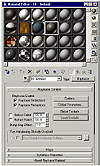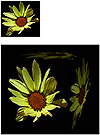| ISO 9000 | ISO 14000 | Forum |
| Mastering 3D Studio MAX R3 |
| Previous | Table of Contents | Next |
Appendix B
Rendering for Large Format Printing
Depending on the nature of your creations, there will be times when you or your clients will want to see the results of your MAX work in printed format. Here, you will learn some quick pointers on how to render your work to get professional, large format prints.
Knowing Output Before Input
As early as possible, you need to determine what your output will be. You need to ask several questions of yourself (or your client) to determine which direction you will go and what information you will need.
- • How big an image will the final output be?
- • How close will the viewer be to the final image?
- • What will the output resolution be?
- • What views will be rendered?
- • How close will the viewer be to the final image?
Focusing on these issues early on can save time in the long run. For instance, if you are building a model that will be seen only from one or two sides, then you do not have to model those areas that will not be seen.
|
| |
| WARNING If you, with your client, determine that only one or two views will be used, make it clear to the client that you are building only what will be seen (and thus saving them money). This way, they won’t be disappointed when they come back to you late in the game and want to add views that haven’t been modeled. |
Reducing Modeling Details
As a general rule, do not spend time modeling those details that you will not see. Modeling more than is needed will slow down the file and slow down the rendering time, not to mention the added time spent creating unneeded geometry.
On the opposite side, insufficient geometry is a common problem. Usually the most glaring example of this lack of detail is found in curves and arcs. If you are creating stills, choosing your views early can enable you to model properly for what will be seen. Curves that take place in the foreground will need to have more segments than those that take place further back in the scene.
Large vs. Small Format
There are details you do not have to model for smaller resolution files that can be visualized by using texture or bump maps. What you will find is that, when the image gets larger, some of these details must then be modeled.
|
| |
| WARNING When you are doing test renders of an image that will eventually become large format, you won’t be able to see at 640 × 480 what you will see at 3600 × 2400. It is prudent to test render at your output size to determine whether your level of detail is sufficient. A region render at the final resolution will allow you to accomplish this without test rendering the entire image. |
For example, a bump map used to create a standing seam in a metal roof may look great on video or for small stills, but it may look odd or just plain bad when rendered for large format output. You can experiment with larger-resolution bitmapped images for your textures, but this usually increases the rendering time by more than it would take for you to do the modeling.
Reducing Rendering Times
Besides careful modeling, there are a couple of other steps you can take to reduce time-intensive, large format rendering.
Shadows
Calculating shadows is time-intensive, especially with raytraced shadows. You can turn off whether an object casts or receives shadows in the Properties window.
|
| |
| TIP You can apply the setting to more than one object at a time. Select several objects that don’t need to cast shadows, and then right-click to access the Properties menu to disable shadows. |
There are some objects that obviously will not need to cast shadows, usually at ground level: grass, water, pavement, and the like. You will need to examine your scene and determine what is applicable. Three-dimensional trees, for example, are extremely heavy in polygons. They definitely need to cast shadows, but do they really need to receive them?
Reflections
Reflection calculations are another machine-intensive process. If you use a raytraced map for your reflections, you can exclude objects from that reflection. Any object you can exclude, especially those high-polygon-count objects, will save you valuable rendering time.
Bitmapped Material Details
The two general rules for using bitmaps in large format rendering are: use the highest level of color possible, and never stretch the bitmap to larger than its current size.
Let’s say you have applied a logo (like the one in the next graphic) to a cube, and your logo bitmap size is 2“ × 2“ at 150dpi. Then in the final output, that cube resides in the foreground of the image taking up 6“ × 6“ at 150dpi. Your logo has been stretched to twice its size. Therefore the pixels that make up the logo are now larger and more obvious.
Bump maps are especially problematic to enlarge. Image files, like the daisy above, are also prone to showing pixelation. Block patterns, such as floor tile, can be easier. You can play with the blurring of an image to help hide the pixelation if no other mode is available to you. This is best done in an imaging program such as *paint or Photoshop.
Including Background Images
When using an image for a background, it’s important that you do not render at a higher resolution than your background image, and that you match rendering resolutions if you are superimposing your render onto the background.
It is often helpful to see, in your viewport, the background image that you’ll be rendering onto. To do this, right-click the viewport label and choose Show Back-ground. (You have previously determined the background in the Views Ø Viewport Background dialog box.) This will display the image in your viewport, but will not render it. In order to render with the image in the background, you must go into the Environment dialog box and specify the bitmap image.
|
| |
| NOTE When using an image for your background viewport, you should be using a lower-resolution duplicate of the high-resolution file you specify in the Environmental dialog box. Using a high-resolution image in the viewport adds no benefit, it only slows things down. |
When rendering scenes that you will be matching or superimposing to a background image, it is important to know the pixel dimension of the background image so that you can match them. If you have a scanned image that is 1950 × 1274 pixels, then your output render from MAX needs to be 1950 × 1274. If you are trying to render at a higher resolution than your background image, your results will be unpredictable at best because the background image will have to be stretched and possibly the aspect ratio changed to accommodate the high-resolution rendering.
Choosing an Output Resolution
Your rendering resolution will be determined by your output. Printer resolution will vary by printer or print process. Call your service bureau to determine your needs early on.
One way to print large format images is using an inkjet printer (plotter). These printers can often use a variety of papers, including heavy papers and semi-gloss or high-gloss papers. The quality of an inkjet print from a normal viewing distance will look like a photographic print. Use the following equation to determine the resolution needs for this type of printer. (insert your printer’s appropriate resolution to determine your specific need):
- • 100(dpi) × Print width (inches) = Pixel
width for rendering
- • 100(dpi) × Print height (inches) = Pixel height for rendering
For example, if you need to render a display that will be printed at 24“ high by 36“ wide then:- • 100 × 36 = 3600 (width)
- • 100 × 24 = 2400 (height)
- • 100(dpi) × Print height (inches) = Pixel height for rendering
Your render setting would be 3600 pixels wide and 2400 pixels high.
|
| ||
| NOTE Remember that you can always use a photographic imaging program to resize your image smaller. Taking a smaller image and trying to increase its size rarely works. | ||
| Previous | Table of Contents | Next |
|
|


